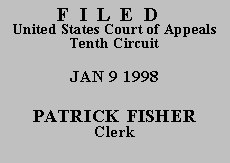

| JAMES E. PATRICK,
vs.
L.E. BRUCE, Ellsworth Correctional
Facility and CHARLES SIMMONS,
Secretary of Corrections |
|
A notice of appeal was filed along with his initial pleading, bringing into question our jurisdiction. While a timely filed motion for reconsideration was pending in the district court, however, Mr. Patrick filed an amended notice of appeal and also filed a brief in this court. Thus, we have jurisdiction. See Fed. R. App. P. 4(a)(4)(C); Smith v. Barry, 502 U.S. 244, 248-49 (1992) (appellate brief may be the functional equivalent of a notice of appeal).
The district court was correct in determining that Mr. Patrick must exhaust his state remedies. See 28 U.S.C. § 2254(b)(1)(A). We DENY Mr. Patrick's motion for issuance of a certificate of appealability and DISMISS the appeal.
Entered for the Court
Paul J. Kelly, Jr.
Circuit Judge
*. This order and judgment is not binding precedent, except under the doctrines of law of the case, res judicata, and collateral estoppel. This court generally disfavors the citation of orders and judgments; nevertheless, an order and judgment may be cited under the terms and conditions of 10th Cir. R. 36.3.
**. After examining the briefs and the appellate record, this three-judge panel has determined unanimously that oral argument would not be of material assistance in the determination of this appeal. See Fed. R. App. P. 34(a); 10th Cir. R. 34.1.9. The cause is therefore ordered submitted without oral argument.
1. Although filed as a civil rights complaint seeking damages, see 42 U.S.C. § 1983, the district court construed the complaint as a challenge to the duration of confinement. See Heck v. Humphrey, 512 U.S. 477, 486-87 (1994) (no cause of action for damages under § 1983 unless prior successful challenge to confinement); Preiser v. Rodgriguez, 411 U.S. 475, 500 (1973). Although Mr. Patrick takes issue with this conversion of his complaint, in light of his contentions on appeal, it is apparent that there is an injunctive component of the relief he seeks. Accordingly, the complaint is properly construed as a habeas petition at this point.